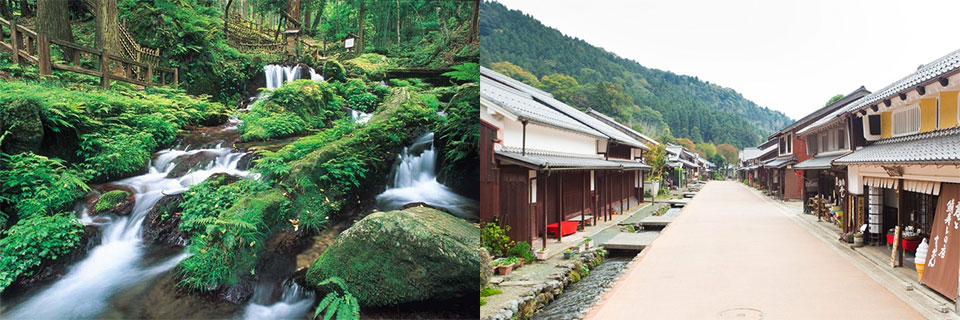About/Getting to Wakasa
What sort of place is Wakasa?
The town of Wakasa is immensely proud of its seas, lakes, and the country landscapes that surround them; it is a town based on the ethos of a recycling society that dates back to the Neolithic Jomon period, as typified by how the Mikata Five Lakes, which have been registered in the Ramsar Convention, receive water full of nutrients from the hills and villages, and feed it into the rich seas around Wakasa.

Wakasa has been one of Japan’s primary entry ports to Asia since recorded history began, a town with a great diversity of history and culture created by these natural gifts. Here, you will find the Uriwari no Taki (Breaking Waterfall), listed as one of Japan’s 100 Exquisite and Well-Conserved Waters; the Torihama Shell Mound, which tells us how people in the long-distant Jomon period lived; and Kumakawa-Juku, which flourished as a post-station town along the old Saba Kaido highway as far back as the Middle Ages.
Wakasa is a precious treasure for many different plants and animals, and of course for we who live here. We feel it is important to pass on together our love of Wakasa, our love of nature, to future generations.
An amazing fact you should know!!!

Some 70,000 years of sediment have been collected from the bottom of Lake Suigetsu, one of the Mikata Five Lakes. This sediment has striped layers, called “varves,” laid down year by year. These varves record what the area around the lake was like, what the climate was like, if there were any earthquakes, and so on. Lake Suigetsu’s varves are now used as a standard geological timescale by scientists around the world. These varves not only tell us about the past, but can perhaps also be used in research to forecast the future.
*Featured in middle school textbooks (Japanese language, Science, Mathematics, Social Studies).
Lake Suigetsu is only going to get more famous!
Getting to the Wakasa Mikata Five Lakes
Time by road from various cities
Kyoto: 2 hours
Osaka: 2 hours 30 minutes
Nagoya: 2 hours
Tokyo: 6 hours 30 minutes
Hiroshima: 6 hours
Time by train from various cities
By Shinkansen or express train
Using either Maibara or Kyoto Shinkansen stations
Shinkansen
Tokyo—Maibara: 2 hours 30 minutes
* 75 minutes by car from Maibara Station to the Mikata Five Lakes
Shinkansen
Tokyo—Kanazawa: 2 hours 35 minutes
Shirasagi Limited Express
Kanazawa—Tsuruga: 1 hour 20 minutes
* 30 minutes by car from Tsuruga Station to the Mikata Five Lakes
Shinkansen
Hiroshima—Kyoto: 1 hour 40 minutes
* 2 hours by car from Kyoto Station to the Mikata Five Lakes
The above times are guides only.
The actual time taken will differ due to train types or connections.
For visitors from overseas
Flying times from Taiwan
Taiwan—Kansai International Airport: 3 hours 15 minutes
Kansai International Airport—Mikata Five Lakes: 3 hours by car
Taiwan—Chubu Centrair International Airport: 2 hours 25 minutes
Chubu Centrair International Airport—Mikata Five Lakes: 2 hours 30 minutes by car
Taiwan—Komatsu Airport: 2 hours 45 minutes
Komatsu Airport—Mikata Five Lakes: 2 hours by car